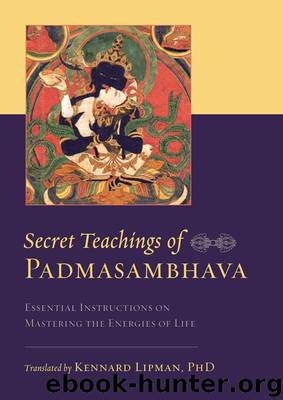Secret Teachings of Padmasambhava: Essential Instructions on Mastering the Energies of Life by Padmasambhava

Author:Padmasambhava
Language: eng
Format: azw3
Publisher: Shambhala Publications
Published: 2011-07-20T03:00:00+00:00
THE HEART OF YOGA
We can apply the same approach to yogic practice. In the Tibetan tantric tradition there are yogic practices such as Yantra Yoga, involving movements and postures, breathing exercises, and visualizations. From a practical standpoint, what is the Dzogchen approach to these practices? If Dzogchen works with what is, in the sense of not struggling to change anything, and yogic practices require discipline and overcoming resistances to regular practice, how can we avoid struggle?
In the Dzogchen view, these resistances, whether they are laziness, perfectionism, chronic health complaints, and so on, are to be respected. In this sense, this way of working has some similarities to the psychotherapeutic understanding of resistances. The resistances are intelligent; they cannot be bullied out of the way by a sovereign ego.
What is the root cause of these resistances? Ignoring and not working with what is. In this case, “what is” means the reality that my body is not just an object, even if I treat it well with good yogic exercises and breathing practices. This reality includes the fact that our body has an unconscious meaning for us and that this meaning needs to be addressed.
How is this meaning addressed in traditional practices? I am not saying here that this is a cultural issue, or that these yogic practices need to be understood in the context of the culture in which they were developed (although that may indeed be useful). Rather, in the traditional context, questions of body image, body ego, the relation of mind and body, and so on, were addressed in terms of the esoteric meditations on the vajra or “energy body,” with its channels and chakras.
Now, the practices of the energy body are not beginning practices of this yoga; they can only really be done (that is, not just as visualizations) after one has mastered the method of held breath known as kumbhaka (Sanskrit), or “vase breathing.” How can one dissolve this difficulty, in which questions of meaning are present from the start, but only seemingly addressed at an advanced level of practice? The solution is to realize first that the esoteric meditations on the energy body are actually the heart of this yoga and can therefore be placed at the beginning; and second, that these meditations can be understood to deal with the psychological issues of the unconscious meanings of the body mentioned above.
To repeat: Dzogchen, the way of self-liberation, is a nongradual path. This means that its principle, the understanding of the reality of self-liberation, can be applied right from the start of the path. Dzogchen, “wholeness,” “completeness,” means that understanding what is, in any moment or situation, is liberating. In Dzogchen this “what is” is explained in terms of essence, nature, and energy.1 So whether one is a beginner or not, the outlook, the practice, and the way of taking the practice out into the world, are the same: to know and experience the essence-nature-energy of one’s situation. This is to maintain beginner’s mind. The essence of
Download
This site does not store any files on its server. We only index and link to content provided by other sites. Please contact the content providers to delete copyright contents if any and email us, we'll remove relevant links or contents immediately.
The Way of Zen by Alan W. Watts(6292)
Ego Is the Enemy by Ryan Holiday(4963)
The Art of Happiness by The Dalai Lama(3851)
The Book of Joy by Dalai Lama(3708)
Why Buddhism is True by Robert Wright(3291)
Spark Joy by Marie Kondo(3089)
Shift into Freedom by Loch Kelly(3032)
Happiness by Matthieu Ricard(2890)
A Monk's Guide to a Clean House and Mind by Shoukei Matsumoto(2786)
The Lost Art of Good Conversation by Sakyong Mipham(2444)
The Meaning of the Library by unknow(2390)
The Third Eye by T. Lobsang Rampa(2174)
The Unfettered Mind: Writings from a Zen Master to a Master Swordsman by Takuan Soho(2160)
Red Shambhala by Andrei Znamenski(2074)
Anthology by T J(2048)
The Diamond Cutter by Geshe Michael Roach(1957)
Thoughts Without A Thinker: Psychotherapy from a Buddhist Perspective by Epstein Mark(1899)
Advice Not Given by Mark Epstein(1767)
Twilight of Idols and Anti-Christ by Friedrich Nietzsche(1764)
